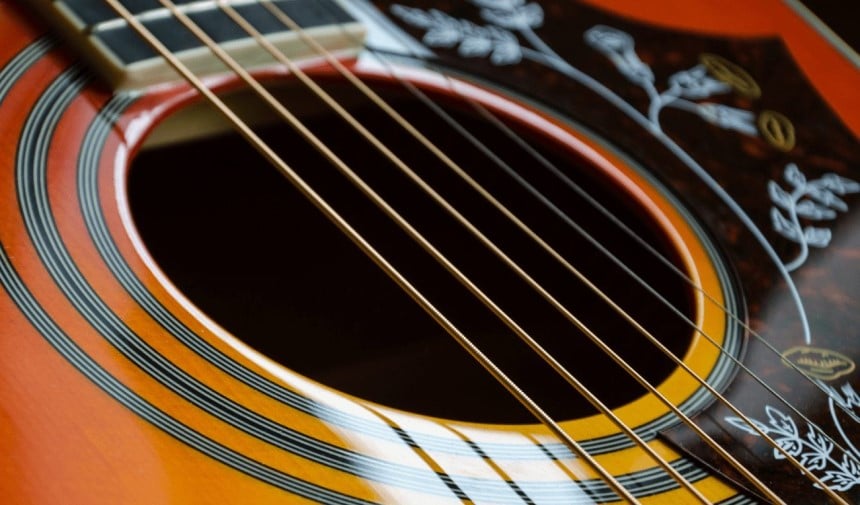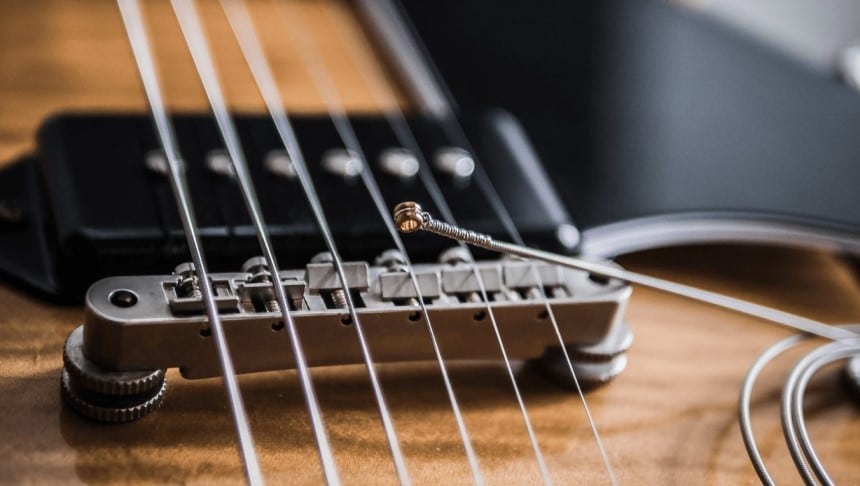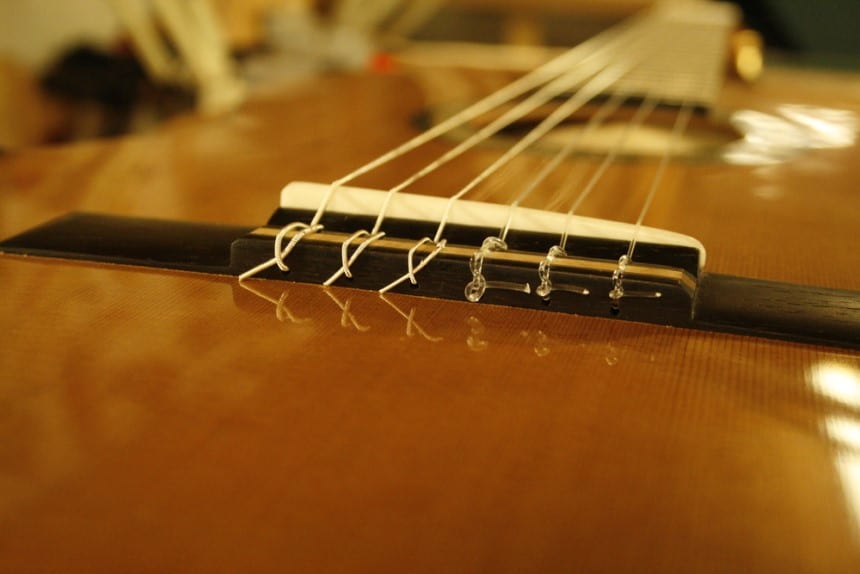Guitar strings are essential in the making of a guitarist’s tone. Choosing the right strings for your genre and playing style is essential in helping you get the most out of your instrument. To make this decision it is important to know what guitar strings are made of. After all, the strings are one of the first links in the chain and there is a great deal of science which goes in their construction and design.
Perhaps you’re a guitar or musical enthusiast or you’re looking to change your guitar string. You should know how guitar strings are made so you can choose the best one for your electric, acoustic, or classic guitar.
These days, guitar strings go through a variety of construction processes which involves material use, gauging, and coating which can significantly impact the comfort, tone, and playability.
Now, let’s go to see in detail all the compositions of the guitar string, taking into consideration the types of guitars we have.
 The string sets for the acoustic guitar usually range from 0.009 to 0.014, where the number indicates the diameter of the thinnest string expressed in inches. Typical gauges are 0.011 or 0.012.
The string sets for the acoustic guitar usually range from 0.009 to 0.014, where the number indicates the diameter of the thinnest string expressed in inches. Typical gauges are 0.011 or 0.012.
The thicker the string, the fuller the sound, but the more difficult it will be to play as more force will be applied: the thicker the strings, the greater the tension the neck will be subjected to.
When you buy a set of strings, generally the strings are separated from each other and have the final part (the one that fits into the bridge so to speak) colored so as not to mistake a string with another E.
Usually, they are also named with the EADGBe nomenclature, to make it easier for you to recognize which string it is. Sometimes, this nomenclature is missing.
Now let’s see what materials are used to build the strings of the acoustic guitar.
There are also those who, to give new life to the strings (for an acoustic and electric guitar), detach them from the guitar. They then put them in a saucepan with boiling water for 3 to 5 minutes, one at a time, drying them and putting them back on. But be careful, even if for some it may be a strategy to save on a new set of strings, it makes them more fragile.
 The sets for the electric guitar range from 0.008 to 0.013 (expressed in inches and referred to the diameter of the thinnest string). The most common diameters on solid bodies are 0.009 and 0.010; larger gauges such as 0.012 or 0.013 are used on semi-acoustics with a deep box.
The sets for the electric guitar range from 0.008 to 0.013 (expressed in inches and referred to the diameter of the thinnest string). The most common diameters on solid bodies are 0.009 and 0.010; larger gauges such as 0.012 or 0.013 are used on semi-acoustics with a deep box.
Finer string, finer sound; thicker string, thicker sound. Even for electric strings, the same thing applies as for acoustic strings: when we buy a set of strings, generally the strings are separated from each other and have the final part (the one that fits into the bridge so to speak) colored to not mistake one string for another.
We think that the finer string scales are more suitable for bending. They are generally easier to play with but it is also easier to break them. And it is easier for them to buzz (especially if we keep the action low). On the other hand, thicker strings are more difficult to play but are suitable for drop tunings and give greater volume.
 Classical guitar and flamenco guitar are very similar but each has its peculiarities. The flamenco for example is built in cypress which gives it a more percussive tone.
Classical guitar and flamenco guitar are very similar but each has its peculiarities. The flamenco for example is built in cypress which gives it a more percussive tone.
The strings of the classical guitar give it a sound completely different from any other type of guitar. They produce a more delicate and less ringing sound than other types of guitars.
Some are made completely of nylon; others have a nylon core and are then coated with silver-plated copper. According to thousands of users, one of the best string set for guitar is made of nylon, that is, the D’Addario Pro-Arte Nylon Classical Guitar Strings. It has normal tension and has silver-plated copper.
In the case of nylon strings, the diameter is not specified; we speak of voltage: low, medium, medium-high, or high voltage. The higher the voltage, the louder the sound.
We strongly advise against using strings other than nylon on the classical guitar. This is because this guitar does not have a truss rod and with the tension exerted by any metal strings, the neck could break.
In general, the guitar string is composed of the core, winding, gauge, and coating in composition.
 Core
CoreSplitting a guitar string up, you see that the main parts that make up a guitar string are the core (or soul) and string.
The core of the guitar string is the heart of the guitar string and its main string. It can appear in two formats: hexagonal or circular. They are found in the following materials: steel, nylon, or nickel.
The metal strings for the guitar can have three different types of windings which means that the string has its own metal core which is then coated with a certain type of winding.
It will be useful to know how to distinguish them to be able to buy a string or a set of strings with knowledge of the facts since these words are expressed on the various packages. When we talk about the covering of a string, we always talk about the 3 largest strings (E, A, and D) and sometimes the G. The B and E sing are always devoid of winding. The three types of windings are the round, half-round, and the flat wound.
The gauge of a string corresponds to its diameter.
As well as the material of manufacture and the covering of the strings, their gauge must also be taken into account when buying or changing the strings of your guitar. This will influence the sound, the ease or not of playing your instrument. The gauge can even wreak havoc on them if you don’t choose the right one.
There are 6 classifications according to the gauge and they are measured in inches. Those of the first type are very light or extra super light. These are ideal for those who like extremely technical solos and songs that demand speed.
The second group and the third group of strings are super light or super light. They are versatile strings and are widely used among musicians of various musical styles.
The fourth and fifth groups correspond to medium or medium and heavy strings or heavy strings. These models are more rigid and hinder speed maneuvers, so they don’t fit in better with blues and jazz musicians.
In the last category, we have heavy or hard and heavy strings. Very difficult to use and few musicians choose them because they are hard and can easily bend the neck of your guitar.
Many types of strings receive a special treatment to increase their durability and prevent oxidation. A layer of synthetic material is applied over the strings in an attempt to prevent sweat, moisture from the environment, etc. from damaging them.
Generally, this type of strings costs a little more than uncoated strings. However, this can be a great option for those students who are too lady to change the guitar strings frequently.
There are various types and compositions of guitar strings for the electric guitar, the classic guitar, and the acoustic guitar.
At one time, the strings were of animal origin, goat or sheep gut. Over time, luthiers have chosen different materials, that are more easily available. To know how guitar strings are made, you have to know what they’re composed of.
Today’s classical guitar has nylon strings – the G, the B, and the E cantino – and nylon wrapped in copper – the E, A, and D.
The electric ones are entirely made of metal, nickel, or bronze, rarely coated in gold or silver: this is because the amplification is entrusted to the magnets and not to the soundbox.
Finally, the acoustic guitar strings are made of bronze, brass, phosphor bronze, and silk, and steel which produce sweet sound and are the most recommended.